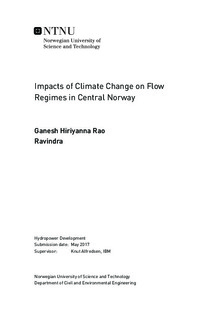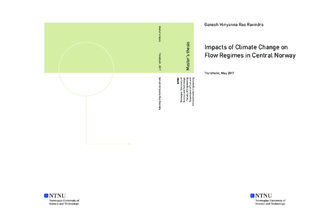| dc.description.abstract | The phenomenon of climate change has had widespread impacts on the climatic and ecological setup of the globe ranging from rapid melting of polar ice caps to startling changes in weather patterns around the planet. From a hydrological standpoint, climate change has had a pronounced impacts on precipitation patterns which has posed a mammoth challenge for the water dependent infrastructures such as domestic water supply systems, storm water drainage systems and the hydropower industries across the globe.
This project aims to add and to strengthen the findings of previous works carried out in the fields of flood frequency analysis and hydrological regimes in a future climatic setup in central Norway. Discerning the future flood patterns in select catchments of central Norway can provide valuable information and insight for decision makers and planners to evaluate and if necessary, modify the existing design of key protective infrastructures such dams, culverts and storm water drainage systems. Furthermore, the findings of the project could help hydropower planners in designing modifications to the existing reservoir operation and power production schemes to cope with the changes imparted to the natural hydrological regime by climate change. Also, the project aims to work towards discerning possible changes to flow regimes in the region which can validate and also strengthen the findings of earlier works.
The project aims at understanding the changes imparted to the natural hydrological regimes in select catchments of central Norway such as Hagabru, Krinsvatn and Svartjonbekken. The chosen catchments represent variability in size, hypsography and distance from the coast and these parameters greatly influence the hydrological regime features of these catchments such as precipitation pattern, snow melt features, seasonality and also influence flow response characteristics.
Upon investigation of the retrieved historical observed discharge time series for these catchments, it was evident that climate change impacts on the annual natural flow regime were already observable. Further, the process of hydrological model calibration for these catchments provided an insight into the complexities in model calibration for the purpose of flood frequency analysis as the project findings showed that a hydrological model calibrated to obtain a general good fit for water balance underperformed when employed for the purpose of flood frequency analysis and vice-versa.
The process of climate data downscaling was particularly challenging and initial analysis revealed that the GCM simulated temperature time series exhibited a high degree of correspondence with the observed temperature time series. But, the GCM simulated precipitation data had a poor correspondence with the observed data which necessitated implementation of a downscaling technique. A new method of precipitation downscaling was devised termed Antinoise Downscaling which helped correct systematic biases within the GCM simulated precipitation data series.
Finally, the calibrated hydrological models for the various catchments were employed to simulate flow regimes in a future time period (2051-2099) to get an insight into the possible ramifications to the natural flow regimes in the catchments with the downscaled GCM precipitation and temperature data series as input.
The results of the investigation revealed that the stream flow pattern would be strongly influenced with exponential reduction in spring flood peak magnitudes. A more evenly distributed flow volumes were observed and also, significant reduction in the amount of available snow cover was observed. A new methodology was implemented for the purpose of analysis of the changes imparted to the flow regimes termed Flow Regime Modification Indices .
Flood frequency analysis was carried out over the historical observation period and also over the future simulation period. The results obtained suggested that the flood magnitudes of respective return periods would be reduced in the future simulation period in all the modeled catchments on an annual basis and also as spring floods. | |

